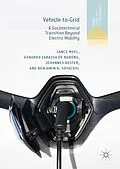This book defines and charts the barriers and future of vehicle-to-grid technology: a technology that could dramatically reduce emissions, create revenue, and accelerate the adoption of battery electric cars. This technology connects the electric power grid and the transportation system in ways that will enable electric vehicles to store renewable energy and offer valuable services to the electricity grid and its markets. To understand the complex features of this emergent technology, the authors explore the current status and prospect of vehicle-to-grid, and detail the sociotechnical barriers that may impede its fruitful deployment. The book concludes with a policy roadmap to advise decision-makers on how to optimally implement vehicle-to-grid and capture its benefits to society while attempting to avoid the impediments discussed earlier in the book.
Lance Noel is a postdoctoral researcher at Aarhus University, Denmark, where he is lead researcher on a $1.6 milliongrant on the sociotechnical benefits and barriers of electric vehicles and vehicle-to-grid in the Nordic region.
Gerardo Zarazua de Rubens is a doctoral fellow at Aarhus University, Denmark, working on energy and transport systems, data analytics and business development. His recent focus has been on Electric Vehicle and Vehicle-to-Grid implementation in Europe.
Johannes Kester is a postdoctoral researcher at Aarhus University, Denmark, working on sociotechnical transformations in electricity and alternative transport systems, energy policy, and the role of security in these transformations.
Benjamin K. Sovacool is Professor of Energy Policy at the School of Business, Management, and Economics, University of Sussex, UK. He is also Director of the Center for Energy Technologies and Professor of Business and Social Sciences in the Department of Business Development and Technology at Aarhus University in Denmark.
Autorentext
Lance Noel is a postdoctoral researcher at Aarhus University, Denmark, where he is lead researcher on a $1.6 million grant on the sociotechnical benefits and barriers of electric vehicles and vehicle-to-grid in the Nordic region.
Gerardo Zarazua de Rubens is a doctoral fellow at Aarhus University, Denmark, working on energy and transport systems, data analytics and business development. His recent focus has been on Electric Vehicle and Vehicle-to-Grid implementation in Europe.
Johannes Kester is a postdoctoral researcher at Aarhus University, Denmark, working on sociotechnical transformations in electricity and alternative transport systems, energy policy, and the role of security in these transformations.
Benjamin K. Sovacool is Professor of Energy Policy at the School of Business, Management, and Economics, University of Sussex, UK. He is also Director of the Center for Energy Technologies and Professor of Business and Social Sciences in the Department of Business Development and Technology at Aarhus University in Denmark.
Inhalt
Foreword by Willett Kempton
Introduction
-Introduction
-Argument
-Novelty and Contribution
-Chapters to Come
Chapter One: History, definition and current state of V2G
-V2G as a Concept
oDefining what is and isn't V2G
-History of V2G
-The technology of V2G
-Actors and Roles of V2G
-Current Global Status of V2G
Chapter Two: Potential of V2G implementation
-Summarizing the benefits of V2G
oEconomic revenuesoTechnical superiority to other forms storage
oAncillary services, grid efficiency
oRenewable energy integration
oMicrogrid, emergency backup, vehicle-to-home
oVehicle-to-X
-From fleets to individuals
-Interactions with super and smart grids
-Conceptualizing future of V2G
Chapter Three: Technical Challenges to V2G
-Battery Degradation-Charger efficiency
-Standards:
oNetwork standards
oCommunication standard (ISO 15118)
-Scaling up aggregation
-V2G & the evolution of the energy systemoDigitalization and big data
oPrivacy, security and safety concerns
oDemocracy and transparency
Chapter Four: Economic and business challenges to V2G
-Costs and revenue
oDecreasing the additional cost of V2G
Bidirectional chargers
Increasing communication capacity
oDouble Taxation
oMoving beyond the low-hanging markets: across markets and across regions-Business models
oPricing and revenue models
oOwnership structure: Aggregators and other actors
oDefining the evolving market: Integration with other technologies
Chapter Five: Political and Regulatory Challenges to V2G
-Regulation:
oDecision-makers and actors interaction
oMarket regulations
Developing and defining the storage market
Net metering
Taxation regulations
-Policy support
oSupport for EVs
oPolitical support for storage markets
Competing storage notions/visions
Authorizing and galvanizing TSO/DSO projects
Pilot Projects and Niche Development
Chapter Six: Society and V2G
-Consumer Perspectives of V2G
oConsumer knowledge and awarenessoFear of Battery Degradation
oConsumer Acceptance - Reliability & Range Anxiety
-Conceptualizing the Consumer in V2G
oDiffusion Studies
oSociotechnical Transitions
oScience & Technology Studies
-Strategies to increase consumer knowledge and acceptance
oTinkering
oEconomic value transfers
oInformation and Education
oExperience -Major social research gaps:
oUser behavior
oCarbon & Health Impacts of V2G
oVision and narratives
oSocial justice
oGender Norms
oUrban resilience & disaster/emergency capacity
Chapter Seven: Deployment Pathways and Policy Recommendations
-General flexible storage policies
-Policies specific to V2G Pilot projects, chargers, standards
-V2G Roadmap for a generalized cou...
